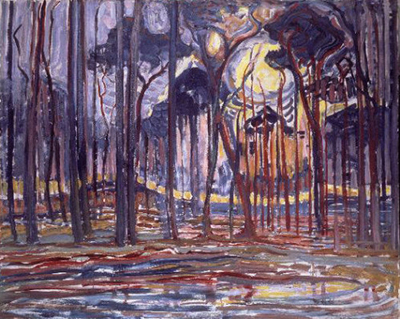Woods near Oele, known originally as Bos bij Oele, is a 1908 landscape painting by Piet Mondrian. It now resides within the permanent collection of the Gemeentemuseum den Haag in The Hague, Netherlands.
This painting is classified by most as having been Post-Impressionist and there are several elements to the artwork that warrant this label. All of the detail is delivered in an expressive manner, where reality is used as a basis but not relied on completely. Mondrian allows himself to restyle the images that he would have seen into an adapted world. Colour was always an important ingredient within his work and here we find a strong use of blue and purple which likely would not have been there originally, but was added by the artist to bring about a more contemporary look. He places tall trees horizontally across the piece, with darker, thicker trunks closer to us. There is also a small opening nearer still on which he sits himself and paints. To the far distance we find a bright sun showing through, with an adapted sky which surrounds the sun with further accentuating lines in a similar manner to Van Gogh's earlier skies, such as The Starry Night. One might also see similarities with the landscape paintings of Munch too, another who worked in an expressive manner.
The artist would feature his beloved Netherlands many times within the earlier part of his career, seeking a chosen art style that he could then continue with for the rest of his career. Ultimately, he would eventually switch to abstract art in a manner which left reality behind but this series of landscape paintings is still very interesting and an important part of his development as a young artist. He would concentrate on city life after moving away and that inspired classics such as Broadway Boogie Woogie and New York City I but it may have been that he merely saw these sprawling metropolises as a means to achieving artistic success and fortune, with his heart perhaps still remaining within the Dutch countryside, in places such as that found here in Woods near Oele.
The artwork is sized at 128 cm in height by 158 cm in width. It is one of several different artworks by Mondrian to be found within the Gemeentemuseum den Haag and they have a good spread of styles which represent the breadth of his work fairly accurately. Much of the artist's work still resides across his native Netherlands and there remains a strong following within the country for his work. Despite the huge competition within this country, because of its exploits and achievements across a variety of artistic styles and periods, it is still generally accepted that Mondrian was one of the most innovative Dutch artists of all time and was particularly important in shaping the direction of contemporary art in the early 20th century, at a time when many changes in society, not just the art world, were afoot. Today he is also seen as the leader of the De Stijl movement, though his time in abstract art arrived several years after the likes of Woods near Oele came along.




